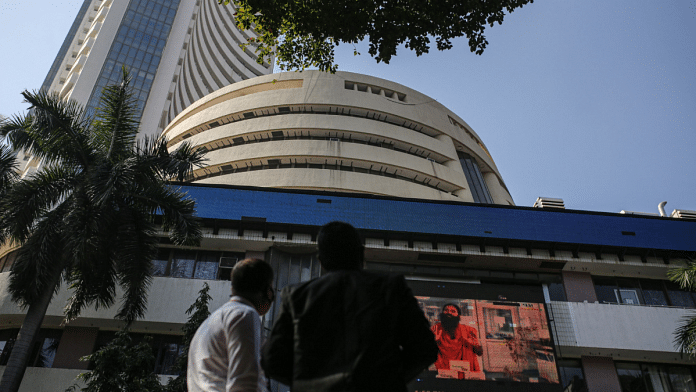
Thank you dear subscribers, we are overwhelmed with your response.
Your Turn is a unique section from ThePrint featuring points of view from its subscribers. If you are a subscriber, have a point of view, please send it to us. If not, do subscribe here: https://theprint.in/
What’s the worry?
“The Union Budget has sent a blow to the bond market with higher than anticipated government borrowing plan and fiscal deficit target for 2022-23. The bond yields in India had hardened to 6.88% the next day after the announcement. “
The government has announced in the union budget that it will increase the gross market borrowing that is expected to be at Rs.14.95 lakh crore for 2022-23 compared to Rs.10.76 lakh crore as per revised estimates of 2021-22. The total expenditure for 2022-23 is estimated to be Rs.39.45 lakh crore, while total receipts other than borrowings are estimated at Rs.22.84 lakh crore giving a difference of 16 lakh crore.
The 10 year bond yields have surged from 5.76% to 6.20% in India sending jitters in the stock market. The bond yields in Australia, US, Canada and UK have elevated to 2.14%, 1.92%, 1.86% and 1.45% respectively. Bond yields are the returns that investors get on the bonds they hold so rising yields would mean that investors expect the bond yields to keep rising but the surging borrowing costs becomes harmful for the government and companies.
The percentage of borrowing to GDP in India has shot up to 57% in 2021-22 versus 50% of GDP in 2019-20. The revised fiscal deficit for 2021-22 is expected to be at Rs.15.91 trillion or 6.9% of GDP marginally higher than budgeted at 6.8% of GDP despite its high expenditure. The deficit is expected to come down to 6.4% of GDP in 2022-23. The Finance Minister of India is planning to bring down the fiscal deficit below 4.5% by 2025-26.
The budget announcement will put pressure on prevailing bond yields that are already elevating and will raise borrowing costs in future. This will impact the financial system and further put upward pressure on general interest rates. As a result, the bond investors would lose their capital on existing bonds they hold hence would want to rush selling them to limit the capital loss.
What’s the root of the worry?
Covid pandemic had derailed the economy because of various restrictions that were imposed to curb the spread of the virus. As a consequence, the tax revenues of government were much lower than projected in 2020-21 since the government had to spend more to set off the adverse impact of pandemic. When the government spends more than it earns for the fiscal year, it runs into fiscal deficit. This is the time when the government has to start borrowing more to bridge the deficit.
Also, during the pandemic the interest rates had been lowered by the central banks accompanied with various government borrowing programmes that had injected liquidity in the market to boost consumer sentiment across the globe and prevent bankruptcies across the companies.
Going forward with the rapid pace of inoculation and gradual lifting up of restrictions, the economies were able to revive the demand. Gradually the demand for products and services exceeded the supply that sent a big invite to global inflation stalling growth. Inflation spike has become a serious cause of concern for the world now.
US consumer prices soar 7.5% in January, the fastest annual pace since 1982 due to soaring energy costs, labour shortages, and demand outweighing is boosting pressure on Federal Reserve to aggressively tighten policy. However, RBI’s monetary policy committee (MPC) stuck to its accommodative policy stance to help the economy recover from the pits of the pandemic, keeping the key lending rates record lows on 10th February 2022 but the economists had expected a rise this time.
Nevertheless, the central banks hence are willing to withdraw liquidity from the market by increasing the interest rates to curb the inflation.
Who takes the pain?
When the central bank borrows through bonds, it has to shell out interest payments that swallows up to 50% of tax revenues and hardly leaves any scope for the government to direct its expenditure towards creating new assets in social sectors.
Higher bond yields makes the task difficult for the government and the corporates as they have to issue bonds at higher interest rates. This hits the profitability of the companies and hurts their debt servicing abilities, abstain them from making fresh investments and as a result crimps the stock prices of the companies. The foreign investors are hence scurrying out of emerging markets bringing anxiety and nervousness in the Indian stock market.
Bottom-line –
The government has been buying excess liquidity from the market through OMO’s to keep yields lower than 6% and avoid steepening of the yield curve. The purpose is to keep lower long term yields to help the centre and firms borrow cheaply from the market.
Also read: Bonds in India tumble as Modi govt unveils record borrowing plan in Budget
These pieces are being published as they have been received – they have not been edited/fact-checked by ThePrint.


COMMENTS